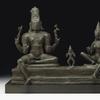Cleveland Museum of Art Acquisitions Range From a Jolly Dutch Portrait to a Cool 1970s Work by Emma Amos
- CLEVELAND, Ohio
- /
- June 18, 2018
Significant recent acquisitions by the Cleveland Museum of Art include The Violin Player, a 17th-century genre painting by Dirck van Baburen; a drawing by Johannes Stradanus, a Netherlandish artist at the Medici court in Florence; an important painting from 1973 by the African American artist Emma Amos; a masterfully carved and unique wooden Bow Stand of the Luba people of south-central Democratic Republic of Congo; and an exceptional, silver-gilt and enamel cigar box by Russian goldsmith Peter Carl Fabergé.
Dirck van Baburen's The Violin Player is a superb example of Caravaggesque technique by 17th-century Utrecht painter.
While in Rome in the early 1600s, van Baburen became fascinated by the work of the Italian painter Caravaggio, known for a style of painting characterized by unprecedented naturalism and dramatic lighting effects. Baburen brought this Caravaggesque style back to the Netherlands to use in his paintings of historical subjects and scenes of everyday life featuring musicians, drinkers, and other marginal types. Fewer than 40 paintings by Baburen are known today, due to the artist’s early death.
The Violin Player represents one of the most characteristic themes addressed by the artist: a half-length figure of a musician, depicted at life size and close to the picture plane. The violin player’s colorful dress marks him as a marginal figure—evidenced by the man’s bold gaze, unshaven face, and cheeky grin complete with a broken tooth. The playful naturalism of Baburen’s painting reflects a typically Dutch interpretation of the Caravaggesque style: an unaffected character who openly enjoys life’s sensual pleasures—music and drink, with a hint of bared flesh. Painted in 1623, one year before the artist’s death, The Violin Player exhibits Baburen’s confident brushwork and characteristic cool, bright tonalities. It is a work of great quality and visual impact, and documents a key moment in the history of northern European painting.
The Violin Player will be presented in gallery 213 in December 2018 when the northern European galleries are refreshed and unveiled.
Sandy and Her Husband by Emma Amos is a significant 1970s painting, coming from the artist’s collection to the museum.
For nearly six decades, Emma Amos has been developing a body of paintings, prints, and textiles that explores African American identity and culture, particularly celebrating women’s presence within that heritage. Amos grew up in Atlanta among a family active in the community of black professionals and local leaders facing racial segregation of the time. Soon after she moved to New York in 1964, Amos became the youngest and only female member of Spiral, a collective of African American artists founded by Norman Lewis, Romare Bearden, Hale Woodruff, and Charles Alston that addressed the relationship among art, race, and activism.
Sandy and Her Husband (1973), one of Amos’s most significant paintings from the 1970s, shows her affinity for color and pattern, which frame the work’s complex narrative. The dancing couple at the center of the painting is joined by Amos: the artist inserted herself into the composition by reproducing an earlier self-portrait, Flower Sniffer (1966), which hangs on the wall behind the couple. Amos is thus part of the composition—even engaging the viewer through her direct gaze—yet she is peripheral to the scene, unseen or ignored by the painting’s protagonists.
Sandy and Her Husband and Flower Sniffer are featured in the exhibition We Wanted a Revolution: Black Radical Women, 1965–85, organized by the Brooklyn Museum and currently on tour. Other paintings by Amos were included in the celebrated touring exhibition Soul of a Nation: Art in the Age of Black Power, organized by Tate Modern in 2017–18. Amos’s first retrospective will open at the Georgia Museum of Art in 2021. Sandy and Her Husband will be on view in the final venue of We Wanted a Revolution: Black Radical Women at the Institute for Contemporary Art/Boston (ICA), June 27–September 30, 2018, and will be installed in the Cleveland Museum of Art’s contemporary galleries later this year.
















